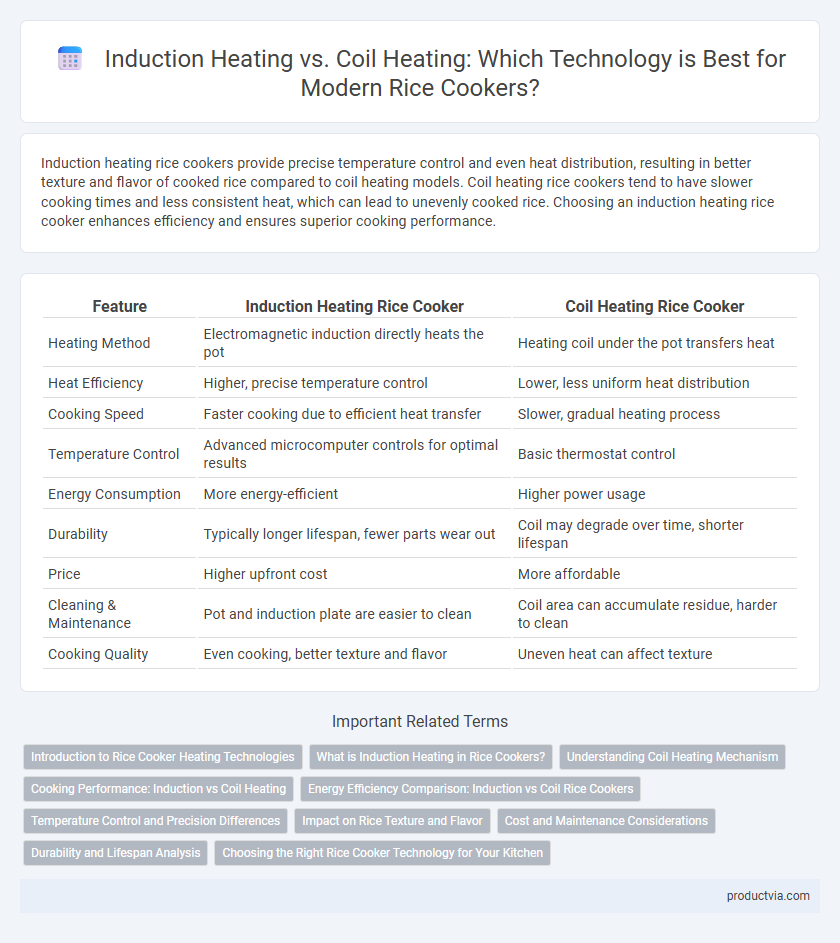Induction heating rice cookers provide precise temperature control and even heat distribution, resulting in better texture and flavor of cooked rice compared to coil heating models. Coil heating rice cookers tend to have slower cooking times and less consistent heat, which can lead to unevenly cooked rice. Choosing an induction heating rice cooker enhances efficiency and ensures superior cooking performance.
Table of Comparison
| Feature | Induction Heating Rice Cooker | Coil Heating Rice Cooker |
|---|---|---|
| Heating Method | Electromagnetic induction directly heats the pot | Heating coil under the pot transfers heat |
| Heat Efficiency | Higher, precise temperature control | Lower, less uniform heat distribution |
| Cooking Speed | Faster cooking due to efficient heat transfer | Slower, gradual heating process |
| Temperature Control | Advanced microcomputer controls for optimal results | Basic thermostat control |
| Energy Consumption | More energy-efficient | Higher power usage |
| Durability | Typically longer lifespan, fewer parts wear out | Coil may degrade over time, shorter lifespan |
| Price | Higher upfront cost | More affordable |
| Cleaning & Maintenance | Pot and induction plate are easier to clean | Coil area can accumulate residue, harder to clean |
| Cooking Quality | Even cooking, better texture and flavor | Uneven heat can affect texture |
Introduction to Rice Cooker Heating Technologies
Induction heating rice cookers utilize electromagnetic fields to heat the inner pot directly, providing even heat distribution and precise temperature control, resulting in perfectly cooked rice. Coil heating rice cookers rely on a traditional heating element beneath the pot, which warms the outer surface and transfers heat less efficiently, potentially causing uneven cooking. The choice between induction and coil heating significantly impacts the rice cooker's performance, energy efficiency, and cooking consistency.
What is Induction Heating in Rice Cookers?
Induction heating in rice cookers uses an electromagnetic field to directly heat the inner pot, ensuring precise temperature control and even heat distribution. This technology allows for faster cooking times and better texture consistency compared to traditional coil heating, which relies on a heating element beneath the pot. Induction heating also reduces energy consumption and enhances durability by minimizing hot spots and overheating risks.
Understanding Coil Heating Mechanism
Coil heating in rice cookers relies on an electric resistance coil positioned beneath the cooking pot to generate heat through direct conduction, ensuring rapid temperature rise. This heating mechanism offers consistent, reliable heat distribution but may result in uneven cooking compared to induction heating due to less precise temperature control. The coil's simplicity and durability make it a cost-effective solution for standard rice cookers, favoring users prioritizing affordability and straightforward operation.
Cooking Performance: Induction vs Coil Heating
Induction heating rice cookers provide more precise temperature control and even heat distribution, resulting in consistently perfectly cooked rice with enhanced texture and flavor. Coil heating models rely on a direct heating element beneath the pot, which can cause uneven cooking and hotspots, sometimes leading to undercooked or burnt rice. The superior cooking performance of induction heating technology makes it ideal for achieving optimal rice quality and versatile cooking settings.
Energy Efficiency Comparison: Induction vs Coil Rice Cookers
Induction heating rice cookers offer superior energy efficiency compared to coil heating models by using electromagnetic fields to directly heat the inner pot, reducing energy loss and cooking time. Coil heating rice cookers rely on a metal heating element beneath the pot, which dissipates more heat into the surrounding environment, leading to higher energy consumption. Studies show induction cookers can save up to 30% more energy, making them a more sustainable choice for efficient rice cooking.
Temperature Control and Precision Differences
Induction heating rice cookers utilize electromagnetic fields to heat the entire pot evenly, enabling precise temperature control and consistent cooking results. Coil heating models rely on a direct heat source from a coil beneath the pot, resulting in less uniform heat distribution and potentially uneven cooking. The advanced temperature regulation in induction heating provides superior precision, reducing risks of overcooking or undercooking rice compared to coil heating technology.
Impact on Rice Texture and Flavor
Induction heating rice cookers provide precise temperature control, resulting in evenly cooked rice with enhanced texture and richer flavor due to consistent heat distribution. Coil heating models often produce uneven cooking, which can lead to rice with inconsistent texture and diminished taste quality. The advanced technology in induction heating promotes optimal starch gelatinization, improving both the fluffiness and sweetness of cooked rice.
Cost and Maintenance Considerations
Induction heating rice cookers generally come with higher upfront costs due to advanced technology and premium materials but offer more even heat distribution, which can lower long-term maintenance expenses. Coil heating models are more affordable initially but may require frequent repairs or replacements of heating elements, potentially increasing maintenance costs over time. Choosing between the two depends on budget constraints and willingness to invest in durable, low-maintenance cooking appliances.
Durability and Lifespan Analysis
Induction heating rice cookers offer superior durability and a longer lifespan compared to coil heating models due to their use of electromagnetic technology, which minimizes wear and tear on internal components. The absence of direct heat contact in induction systems reduces the risk of damage and extends the operational life of the cooker's heating element. Coil heating rice cookers typically experience faster degradation as the exposed metal coils are prone to rust, corrosion, and uneven heating, shortening their overall lifespan.
Choosing the Right Rice Cooker Technology for Your Kitchen
Induction heating rice cookers provide precise temperature control and even heat distribution through electromagnetic fields, resulting in perfectly cooked rice with enhanced texture and flavor. Coil heating models rely on traditional electric coils that heat the cooking pot indirectly, often leading to uneven heat and longer cooking times. Selecting an induction heating rice cooker offers efficiency and consistent results, ideal for kitchens prioritizing advanced technology and superior cooking performance.
Induction heating vs coil heating for rice cooker technology Infographic

 productvia.com
productvia.com